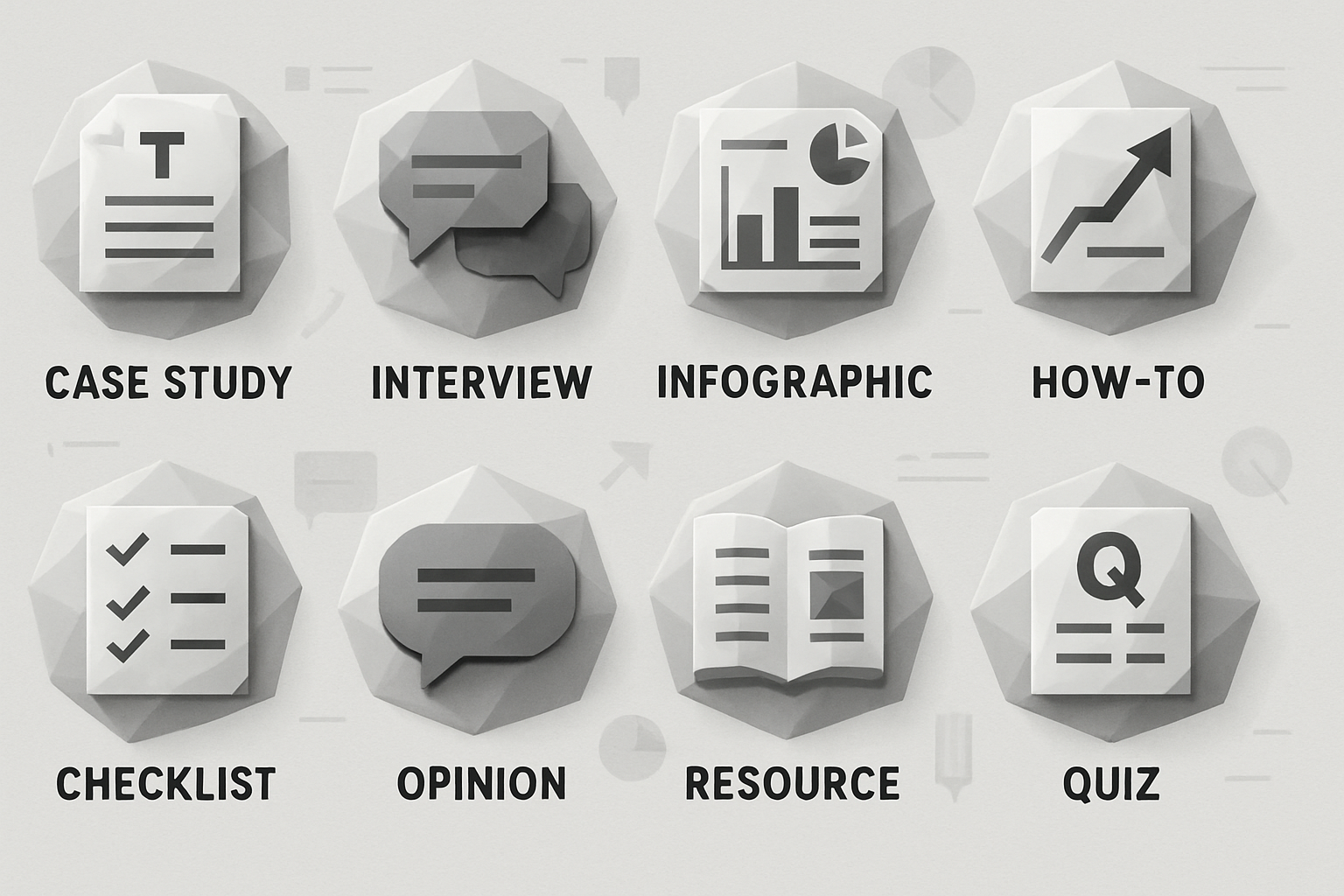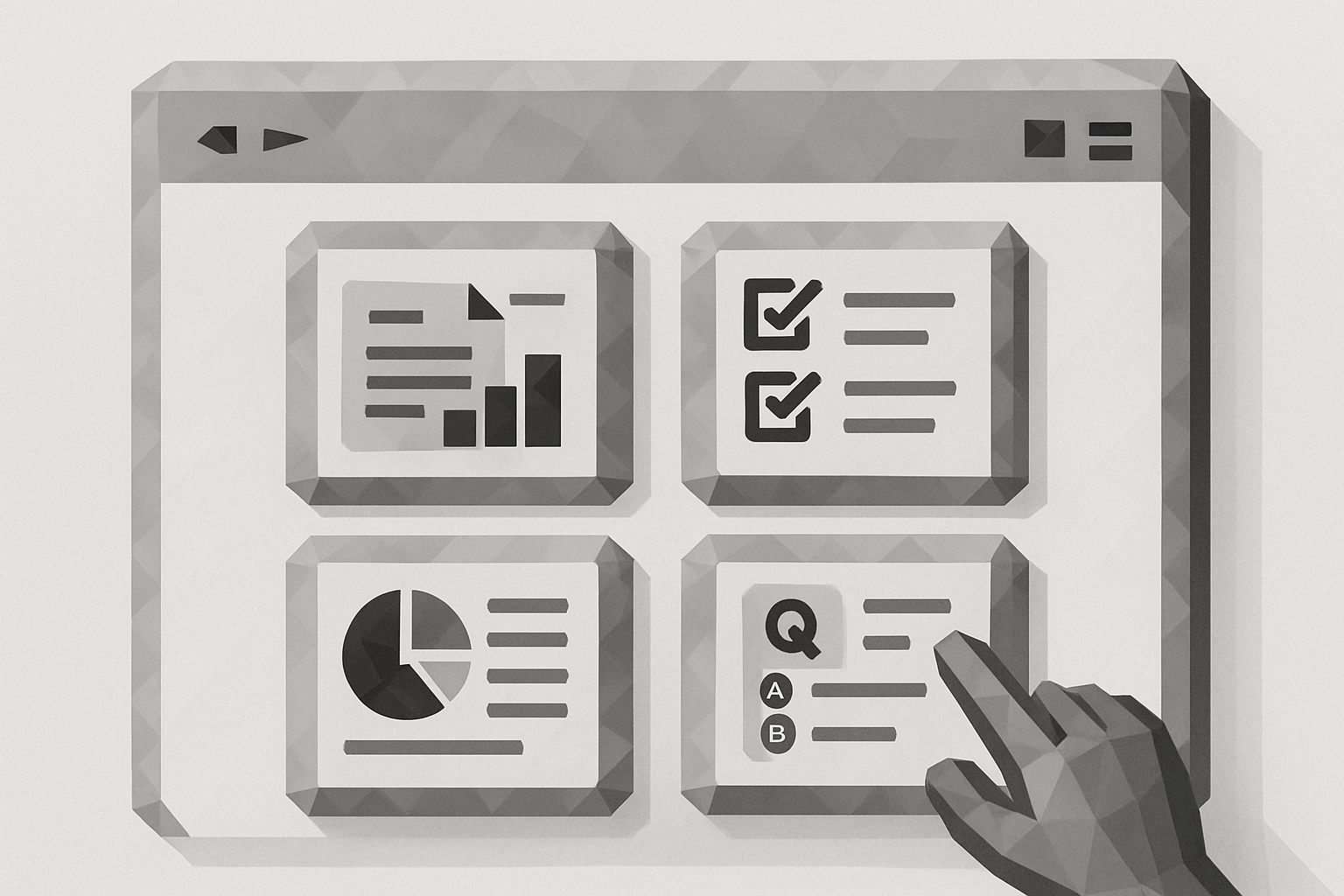Struggling to keep your blog fresh and engaging in a rapidly changing digital landscape? You’re not alone. In 2025, standing out means going beyond the basics and experimenting with new blog post types that can help you capture attention, build trust, and drive consistent traffic.
This article will introduce you to 10 innovative blog post types designed to boost your SEO, grow your authority, and future-proof your content strategy. We’ll explain why each format works, share actionable tips, and encourage you to try these fresh approaches.
Ready to transform your blog and stay ahead of the curve? Let’s dive in.
Why Diversifying Blog Post Types Matters in 2025
The digital landscape is evolving rapidly, and so are the expectations surrounding successful blog post types. In 2025, simply sticking to one format won’t cut it. Readers crave fresh experiences, while search engines reward sites that offer a mix of value, visuals, and interactivity. Let’s break down why mixing up your blog post types is so crucial this year.

The Evolving Content Landscape
Reader preferences are shifting toward more diverse blog post types, driven by the rise of multimedia, interactive features, and value-driven storytelling. No longer are plain articles enough; audiences expect a blend of videos, infographics, and hands-on tools. According to top blogging statistics for 2025, blogs that use a variety of formats can achieve up to 30% higher reader retention.
This shift isn’t just about trends—it's about adaptability. Those who evolve their blog post types stay relevant and future-proof their content. By embracing new formats, you ensure your blog appeals to today’s—and tomorrow’s—readers.
SEO Benefits of Content Variety
Diversifying your blog post types can help you target a broader range of keywords and search intents. Google favors sites that deliver comprehensive, user-focused content, rewarding those who go beyond basic articles. Data shows that list posts and how-tos consistently rank among the top search results.
Infographics and case studies, for example, are known to attract quality backlinks, which in turn boost your domain authority. By mixing your blog post types, you build topical authority and increase your chances of ranking for multiple queries. The result? More organic traffic and a stronger online presence.
Audience Engagement and Retention
A variety of blog post types keeps readers engaged and encourages them to return for more. Interactive and visual posts, such as quizzes or infographics, naturally increase time-on-page. Checklists and downloadable resources are highly shareable, often generating repeat visits and higher newsletter sign-ups.
Blogs that offer a mix of content formats can better meet the different learning and consumption preferences of their audience. This diversity ensures your readers always find something valuable, regardless of how they like to engage with content.
Staying Ahead of Competitors
Many blogs still rely on repetitive formats, missing out on the benefits of innovative blog post types. Early adopters of new formats—like infographics or expert roundups—often see viral growth and increased brand recognition.
Building a “resource file” of different blog post types can help you combat writer’s block and keep your content pipeline fresh. The key is to experiment with formats, monitor results, and refine your approach continuously. By staying curious and proactive, you’ll maintain a competitive edge in 2025.
10 Blog Post Types You Should Try in 2025
Ready to transform your content strategy for the year ahead? If you’re searching for blog post types that deliver results in 2025, you’re in the right place. The digital landscape is evolving, and sticking to the same old formats can leave your blog buried under fresh, innovative competitors.
Below, we’ll break down ten blog post types that not only attract attention but also boost SEO, increase engagement, and keep your readers coming back for more. Whether you’re a seasoned blogger or just starting out, these formats will help you diversify your content and future-proof your strategy.

1. Data-Driven Case Studies
Data-driven case studies stand out among blog post types because they showcase real results with actionable insights. Structure them by clearly defining the problem, outlining your approach, presenting the data-backed results, and wrapping up with a key takeaway.
For example, “How Brand X Increased Traffic by 123% in 6 Months” grabs attention and demonstrates value. Use visuals like charts, before/after screenshots, and statistics to enhance credibility. Including client quotes and step-by-step breakdowns builds trust and authority.
Case studies are especially powerful for B2B audiences and often attract quality backlinks, as others reference your proven methods. According to industry research, case studies are among the most-shared B2B blog post types, making them an essential addition to your 2025 content mix.
2. Expert Roundups & Interviews
Expert roundups and interviews gather insights from multiple thought leaders, making them one of the most versatile blog post types. You can present these in written Q&A, video, or podcast formats.
A strong example is “10 SEO Experts Share Their Top Content Trends for 2025.” This approach not only increases your credibility but also encourages social sharing, as featured experts are likely to promote your post to their networks.
To maximize impact, ask specific, forward-looking questions and feature a diverse range of voices. Roundups are known to generate high referral traffic, as contributors share the post widely. These blog post types expand your reach and help you tap into new audiences while building authority in your niche.
3. Visual Infographics & Data Visualizations
Visual infographics and data visualizations simplify complex information, making it easy for readers to digest and share. These blog post types combine statistics, illustrations, and concise text to create engaging, skimmable content.
Try an “Ultimate Blogging Checklist for 2025 (Infographic)” that uses icons, flowcharts, and bold numbers. Infographics are proven to increase web traffic by up to 12%, according to recent blogging statistics and facts for 2025.
Use tools like Canva or work with a designer for professional results. Infographics drive backlinks, social shares, and increase time-on-page. These blog post types are especially effective for visual learners and audiences who prefer quick takeaways.
4. Comprehensive How-To Guides
Comprehensive how-to guides are among the most popular blog post types for organic traffic. They provide step-by-step solutions to common problems, making them a go-to resource for readers.
Structure your guide with a clear introduction, a list of materials or prerequisites, detailed steps, troubleshooting tips, and a summary. For example, “How to Build an AI-Powered Content Calendar in 2025” can include screenshots, video walkthroughs, and downloadable templates.
These blog post types rank well for “how to” and long-tail queries, driving consistent search traffic. To stand out, ensure your guide is thorough, actionable, and updated regularly as new tools or methods emerge.
5. Actionable Checklists & Cheat Sheets
Actionable checklists and cheat sheets are concise blog post types that offer readers a quick reference or step-by-step sequence. Their simplicity makes them highly shareable and perfect for repeat visits.
Imagine “The 2025 Blog Launch Checklist: 20 Steps to Success” presented as a printable PDF or interactive list. Use bulleted lists, tick boxes, and clear, bite-sized instructions. These formats are often used as lead magnets to boost email sign-ups.
Checklists are frequently bookmarked and revisited, especially in time-strapped industries. By focusing on practical, actionable tasks, you make your blog post types indispensable resources for your audience.
6. Controversial or Opinion Posts
Controversial or opinion posts are bold blog post types that spark discussion and engagement. By presenting a contrarian viewpoint, you invite comments, shares, and debates—perfect for increasing your blog’s visibility.
For example, a post titled “Why AI Won’t Replace Human Bloggers—Yet” challenges popular beliefs and encourages readers to weigh in. To succeed, back up your claims with evidence and invite readers to share their perspectives.
These blog post types tend to see higher engagement rates but require careful moderation to keep discussions respectful. Use them strategically to position your brand as a thought leader and to energize your community.
7. Trend Forecasts & Predictions
Trend forecasts and predictions analyze industry data to anticipate future changes, making them some of the most forward-thinking blog post types. Readers look to these posts for guidance and insights on what’s next.
A compelling example is “Top 7 Blogging Trends to Watch in 2025.” Use credible sources, charts, and revisit your predictions for transparency. These blog post types position your brand as a trusted authority and attract both industry peers and curious readers.
Forecast posts are also excellent for networking, as they often get shared among thought leaders and trend-watchers, boosting your reach and influence.
8. Resource & Tool Roundups
Resource and tool roundups are invaluable blog post types for readers who want to save time researching the best solutions. Curate lists like “15 Free AI Tools Every Blogger Needs in 2025,” and provide brief descriptions, pros and cons, and direct links.
Keep these posts updated to maintain relevance. Resource roundups are highly shareable, generate affiliate revenue, and attract backlinks, making them a staple in any content calendar.
These blog post types are evergreen, ensuring ongoing traffic and engagement as new readers discover your curated recommendations.
9. Personal Stories & Lessons Learned
Personal stories and lessons learned are authentic blog post types that humanize your brand and build trust. Share your challenges, failures, and growth moments to connect with readers on a deeper level.
A post like “What I Learned from Publishing 100 Blog Posts in a Year” invites empathy and encourages readers to share their own experiences. Include actionable takeaways and be honest about both successes and setbacks.
Story-driven blog post types foster a sense of community and inspire your audience to engage, comment, and return for more relatable content.
10. Interactive Content & Quizzes
Interactive content and quizzes are dynamic blog post types that boost engagement and data collection. Use polls, calculators, or quizzes like “Which 2025 Blogging Strategy Suits Your Brand?” to keep readers actively involved.
Platforms like Typeform make it easy to embed interactive elements directly into your posts. Interactive content generates twice as many conversions as static content, making it a powerful addition to your toolkit.
These blog post types increase time-on-site, encourage sharing, and provide valuable insights into your audience’s preferences and needs.
Summary Table: Blog Post Types at a Glance
| Blog Post Type | Key Benefit | Example Title |
|---|---|---|
| Data-Driven Case Studies | Builds authority | How Brand X Increased Traffic by 123% in 6 Months |
| Expert Roundups & Interviews | Expands reach | 10 SEO Experts Share Their Top Content Trends |
| Visual Infographics | Boosts shares | The Ultimate Blogging Checklist for 2025 |
| Comprehensive How-To Guides | Attracts organic traffic | How to Build an AI-Powered Content Calendar |
| Actionable Checklists | Drives return visits | The 2025 Blog Launch Checklist |
| Opinion Posts | Sparks discussion | Why AI Won’t Replace Human Bloggers—Yet |
| Trend Forecasts | Positions as authority | Top 7 Blogging Trends to Watch in 2025 |
| Resource Roundups | Evergreen value | 15 Free AI Tools Every Blogger Needs |
| Personal Stories | Builds trust | What I Learned from Publishing 100 Blog Posts |
| Interactive Content | Increases engagement | Which 2025 Blogging Strategy Suits Your Brand? |
For even more ideas and insights, check out this guide on SEO content creation strategies to help you choose and implement the most impactful blog post types for your goals.
How to Choose the Right Blog Post Type for Your Audience
Selecting the most effective blog post types for your audience is crucial if you want to maximize engagement, SEO impact, and long-term growth. With so many formats available, it’s easy to feel overwhelmed. The key is to combine data-driven insights with a strategic approach, ensuring every post type you publish resonates with your readers and supports your business goals.

Assessing Your Audience’s Needs and Preferences
Start by analyzing your audience’s behavior and feedback to determine which blog post types truly resonate. Dive into your analytics to see which formats drive the most traffic, engagement, and conversions. Don’t hesitate to run surveys or quick polls asking readers what they’d love to see next.
For example, B2B audiences often gravitate toward data-driven case studies, while B2C readers may prefer interactive quizzes or personal stories. In time-sensitive industries, checklists tend to perform well, as SmartBug Media notes. By tailoring your blog post types to these preferences, you’ll keep your content relevant and your audience coming back for more.
Aligning Post Types with Content Goals
Every blog post type serves a different purpose. To get the best results, map your chosen formats to specific goals like boosting traffic, generating leads, or building authority. For instance, comprehensive how-to guides are perfect for attracting search traffic, while expert roundups can help you network and expand your reach.
If your goal is to improve SEO, consider writing articles for SEO that are structured to rank for targeted keywords. Use infographics to earn backlinks, and leverage list posts for viral potential, as ProBlogger suggests. Setting clear KPIs for each blog post type will help you measure what’s working and refine your approach.
Leveraging Trends and Technology
Stay ahead by embracing the latest trends and tools for content creation. Experiment with new blog post types powered by technology, such as AI-generated content, interactive infographics, or even AR/VR experiences. Early adoption can give your blog a noticeable edge in a crowded space.
Platforms and AI tools for content creation make it easier than ever to produce engaging, innovative formats. Test emerging blog post types with pilot articles and gather feedback to see what your readers enjoy most. Investing in upskilling or forming strategic partnerships can further expand your content possibilities.
Building a Sustainable Content Calendar
To maintain consistency and maximize results, plan a balanced content calendar featuring a variety of blog post types. Alternate between evergreen formats like how-tos and checklists, and timely content such as trend forecasts or resource roundups. This approach ensures you’re always delivering value while staying relevant.
Use editorial calendar tools to organize your posting schedule and automate reminders. Rotate your blog post types to address multiple goals—such as SEO, engagement, and authority—throughout the month. Regularly review your analytics to fine-tune your content mix and keep your strategy fresh.
Ready to put these blog post ideas into action and see your traffic grow in 2025? With all the new formats and strategies we’ve covered, I know it can feel like a lot to juggle—but you don’t have to do it alone. If you want to save time, stay consistent, and have AI help with content creation and keyword research, let’s make your content calendar work smarter, not harder. Why not explore how RankPill can help you automate and amplify your blogging strategy? Get Started and see how effortless great SEO content can be!